Legend has it that a 16th-century Spanish galleon sunk off the coast of Maryland, succumbing to the gigantic waves of a powerful storm. The horses it was carrying survived, swimming to safety on the shores of Assateague Island, where they still live today.
Over centuries these domesticated horses re-adapted to life in the wild, eating marsh and dune grasses and drinking water from ponds. The island they now call home attracts hundreds of thousands each year to see these majestic creatures galloping on the untouched sands of the Eastern Shore.
How to see horses on Assateague Island
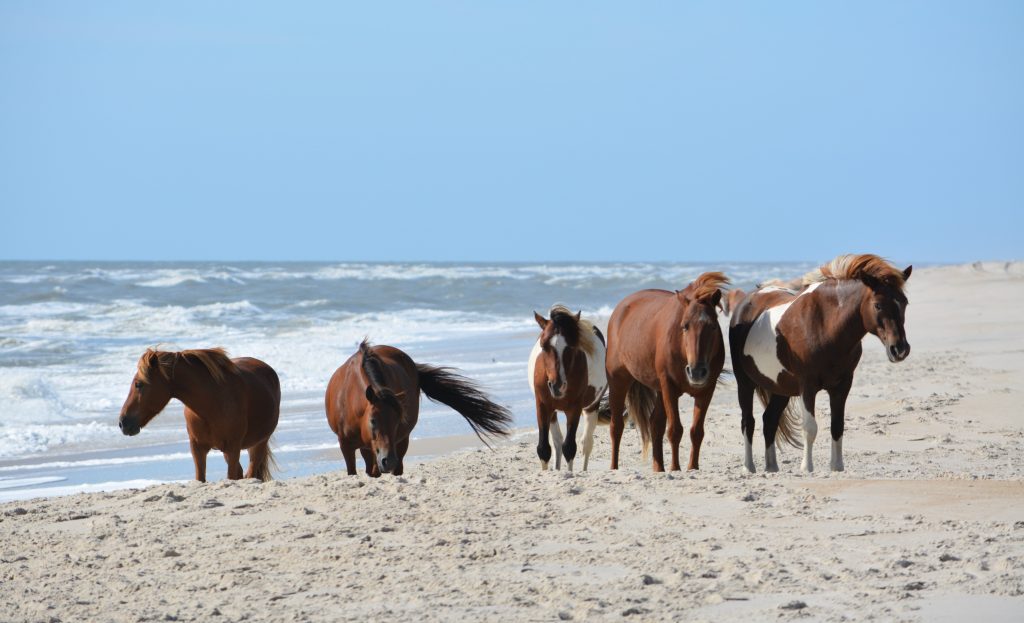
Assateague Island is a 37 mile long island off the eastern coast of the United States, with the Maryland/Virginia state border running through the middle. The Assateague Island horses are split into two groups:
- Maryland herd in the North
- Virginia herd in the South
The two herds are literally separated by a fence at the Maryland/Virginia state line, and the differences don’t stop there.
The most popular place to see the wild horses is from the Virginia side of Assateague, accessed through Chincoteague Island, home to the popular “Pony Swim”. The Virginia side has more horses than the Maryland side, including many young horses (called foals), but they’re fenced off and difficult to see unless you take a boat tour. Although there’s lots to do in the Virginia section of Assateague and nearby Chincoteague Island, it’s also more touristy.
The best place to see the wild horses in Assateague is from the Maryland side of the island. The horses are free to roam which means you could see them anywhere at any time. Although there are less horses and double the space, you’ll also have a less crowded experience, and you’re almost guaranteed to see horses on any given day.
You cannot drive from one end of Assateague Island to the other while on the island itself- the fence at the Maryland/Virginia State border prevents vehicles and pedestrians from crossing, too. The only way to travel between the Maryland entrance on the northern end and the Virginia entrance on the southern end is by making the hour long drive between entrances on the mainland.
Assateague Horses in Virginia
The Virginia herd of 150 ponies live on Chincoteague National Wildlife Refuge and are owned by the Chincoteague Volunteer Fire Company. Although the wildlife refuge is named after nearby Chincoteague Island, it’s actually located on Assateague Island.
To prevent overgrazing and detrimental effects to the ecosystem, they have a creative method of limiting the herd to 150 horses: an event each summer called the Pony Penning Festival that features the beloved “Pony Swim”.
Pony Swim
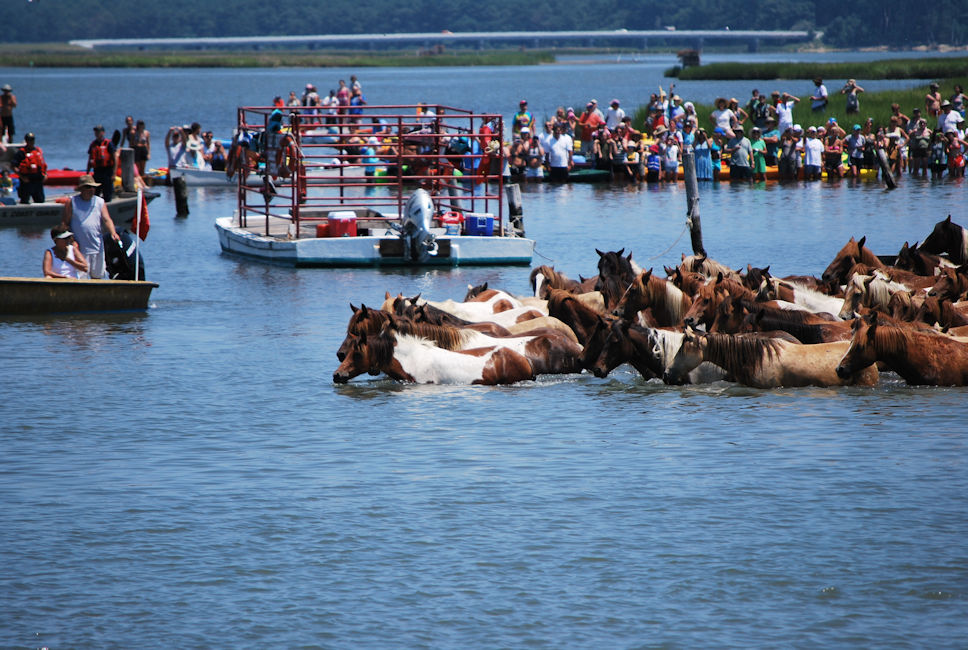
On the last Wednesday/Thursday in July, the “Saltwater Cowboys” round up all the foals (3 months or older), and swim them from Assateague Island to Chincoteague Island, attracting tens of thousands of spectators each year.
The ponies swim across the Assateague Channel, where onlookers in boats cheer them along from feet away. After arriving on shore at Pony Swim Lane, they’re paraded into town and auctioned off. It’s a spectacle worth seeing at least once.
Chincoteague Ponies
Despite living on Assateague Island, the Virginia herd became an officially registered breed known as the Chincoteague Pony in 1994. The name “Chincoteague Pony” was selected for several reasons:
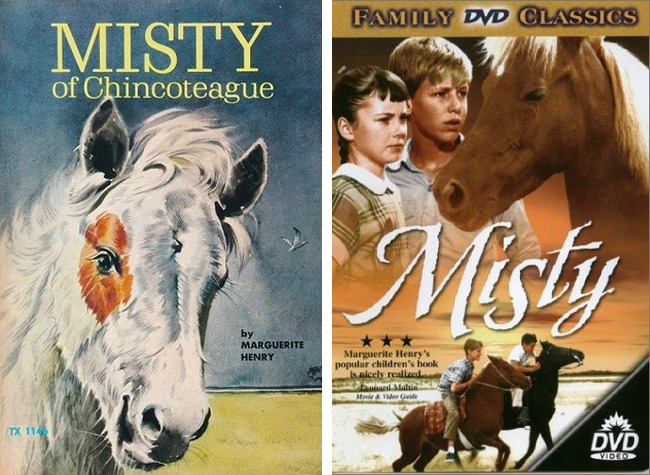
- The name was made popular by award-winning children’s book “Misty of Chincoteague” in 1947. It became a popular movie (“Misty”) in 1961, further contributing to its rise.
- The Virginia herd is privately operated and has monetary incentives. For example the Chincoteague Pony Auction generates $150,000/year for the Chincoteague Volunteer Fire Department and the tourism it generates supports businesses in the historic town nearby.
- Although they’re on Assateague Island they live in the Chincoteague Wildlife Refuge, giving the name some credence.
Although called separate names, Chincoteague Ponies and Assateague Horses are the exact same thing, just managed by different groups and separated by a fence at the Maryland/Virginia state line. The Chincoteague Ponies experience much more human intervention while the Assateague Horses are left to roam as true wild animals.
Are they Ponies or Horses?
Ponies and Horses are NOT different types of animals. The only difference between a Pony and Horse is their size: all horses less than 57-inches tall are called Ponies.
Horses are typically measured in “hands”, a system of 4-inch increments originating in ancient Egypt. The animal’s height is measured from the ground to the ridge its shoulders. If the animal is 14 hands or taller, it’s a horse. If it’s less than 14 hands, it’s a pony.
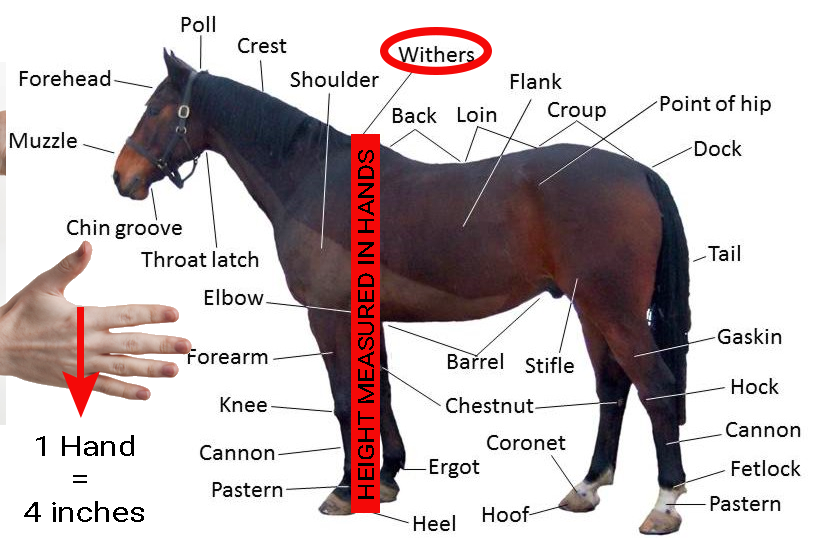
Assateague Horses are above 14 hands tall when domesticated and properly fed, making them horses. However, due to their harsh environment and limited diet while living in the wild, many of these animals never grow above 14 hands, making them ponies.
That means Chincoteague Ponies can be horses and Assateague Horses can be ponies. Whatever you call them, they all appear rather stocky, with big bellies that grow fur in the colder weather.
Where to see the ponies in Chincoteague National Wildlife Refuge
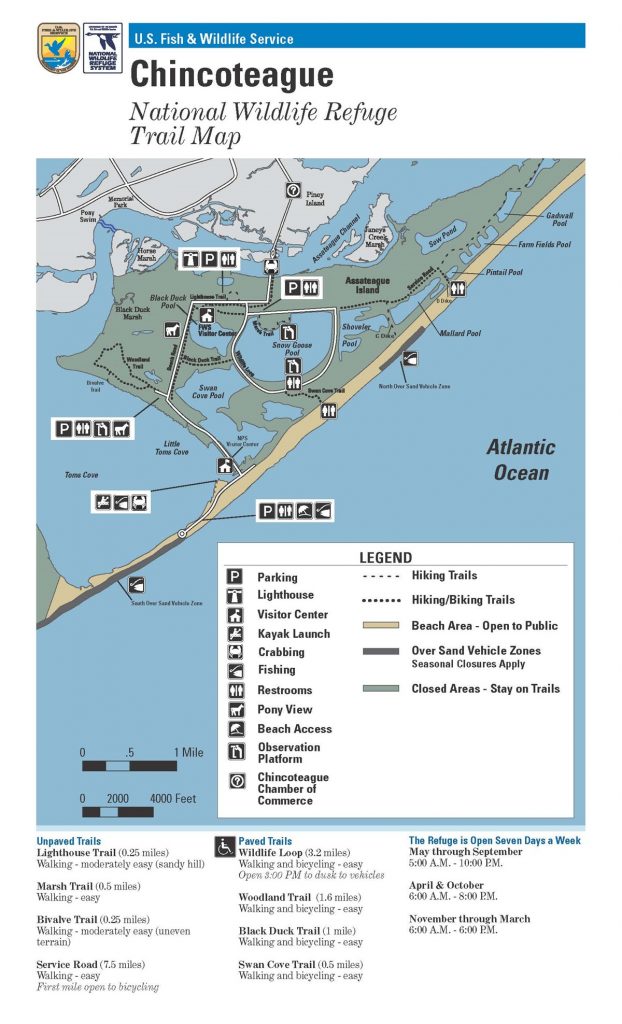
The best way to see to the Chincoteague Ponies in Virginia is by starting at the Toms Cove Visitor Center. Here you can get up to date information on the horses whereabouts, recent patterns, and any conditions or events that would affect your ability to see them.
The best way to see the south herd of Chincoteague ponies is a chartered boat tour. This allows you to visit areas of the wildlife refuge otherwise inaccessible, bringing you much closer to the ponies themselves. Some services even have a money-back guarantee that you’ll see ponies. If traveling by foot, you can often spot them grazing the marshes near Beach Road or from the Woodland Trail observation platform.
Things to do in Chincoteague area
You may be visiting Chincoteague just to see the ponies, but there’s so much more to do:
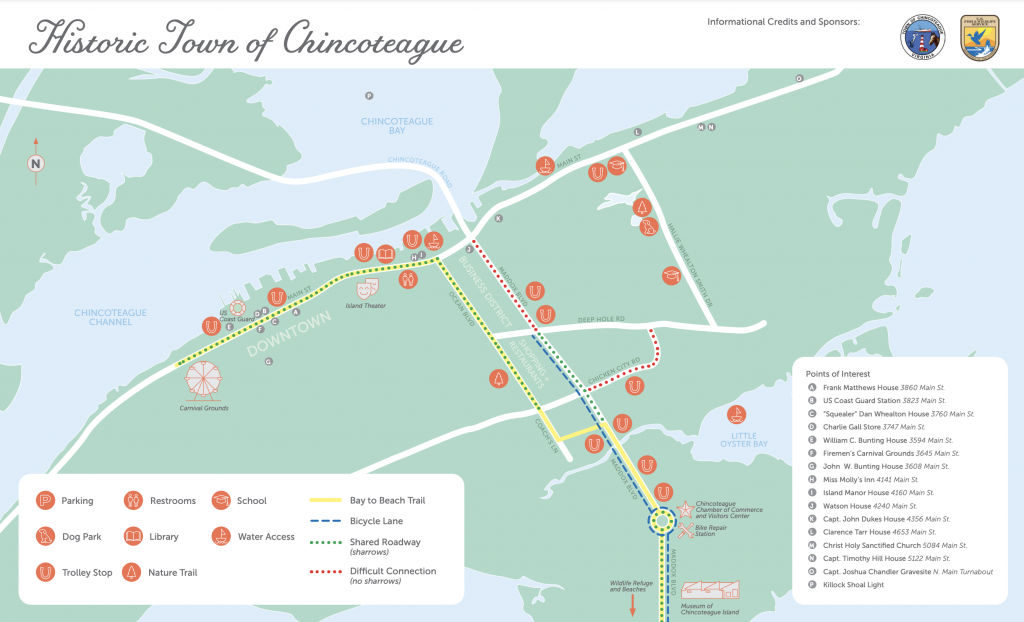
- Start at the Herbert H. Bateman Educational Center to get acquainted and Tom’s Cove Visitor Center is also worth a stop
- Explore a diverse ecosystem, from sandy beaches filled with shells (the Tip of Tom’s Cove) to marshes and forests filled with rare birds (like the Piping Plover and Bald Eagles), in the Chincoteague National Wildlife Refuge
- Hike & Bike over 17 miles of trails across 14,000 acres and stop at many points of interest along the way. (You can rent bikes from Bike Depot)
- Enjoy the water by renting a boat, canoe, or kayak, taking a guided boat tour or cruise (or swim for free!).
- Watch a rocket launch into space at nearby NASA Wallops Flight Facility, often delivering supplies to the International Space Station.
- Climb to the top of the 142-foot tall Assateague Island Lighthouse lighthouse built in 1867.
- Follow in the footsteps of Misty of Chincoteague (PDF)
- Learn the local history at the Museum of Chincoteague Island
- Take a self-guided walking tour of Historic Downtown Chincoteague
- Go Crabbing! It’s simple: visit a local bait shop, buy some cheap tools (bucket, net, bait clip, string, and chicken necks), and catch up to a bushel of crabs a day (must follow size requirements)!
- If you’ve got kids, the Chincoteague Pony Center lets you safely get up close and personal, allowing kids to pet and ride the ponies.
- Plan ahead and visit during one of Chincoteague’s big events (Pony Penning Week, Spring & Fall Roundup)
Assateague Horses in Maryland
The National Park Service is responsible for the Maryland herd of Assateague horses. Although they also limit their herd population, they do so in a very different way: by shooting the horses with contraception darts from a distance, preventing them from generating offspring.
That means you won’t likely see baby horses in Maryland’s side of Assateague, but the lack of human intervention keeps these wild horses more wild, something nature lovers will appreciate. If you want to see horses wandering sandy beaches with waves crashing nearby, the Maryland side of Assateague is the place to go.
Where to see the horses in Assateague
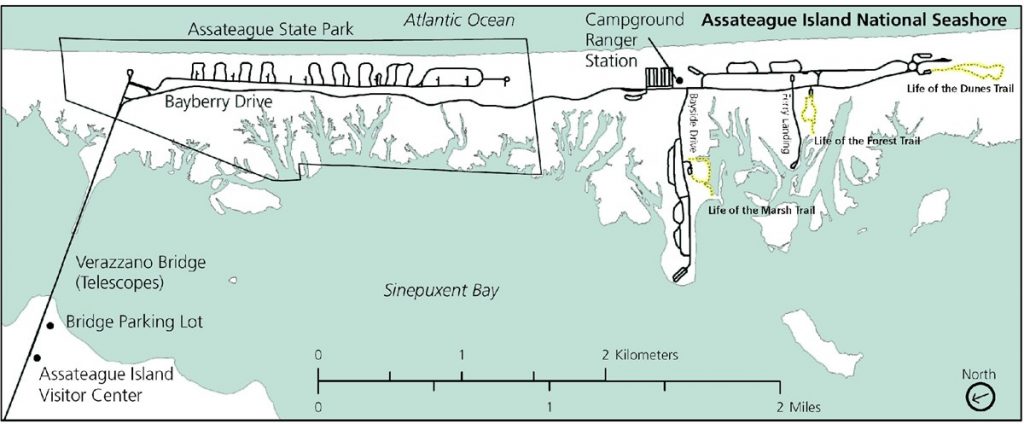
The first place you should stop is at the Assateague Island Visitor Center, found just before the Verazzano Bridge to Assateague Island. Here you can get the latest information on the horses’ whereabouts and happenings in both Assateague State Park and Assateague Island National Seashore.
After crossing the Verazzano Bridge, you’ll find yourself in Assateague State Park, where the horses roam free, wandering the roads, beaches, and marshes along Bayberry Drive.
If you pay the small fee to enter Assateague Island National Seashore, you’ll be treated to a huge area to explore, including several hiking trails where you can best see the Assateague horses in their adopted natural environment.
Maryland’s Assateague horses freely graze 27-miles of Assateague Island, island. They’re on the move 10 to 12 hours each day, constantly traveling between food and fresh water sources, so they’re never at a particular place at a particular time. You’ll almost always see horses on a visit to Assateague Island in Maryland, but the mystery and exploration are half the fun!
Can you touch or feed the horses?
Assateague horses and Chincoteague ponies are wild animals and you should always stay at least 40 feet away. If they approach you, slowly retreat. They may look like peaceful pets, but they’re wild animals that are likely to kick or bite if approached.
You should never touch or feed the horses. For these wild animals to remain wild, we need to show collective restraint by letting them enjoy the beach in peace, just as we prefer ourselves.
Things to do in Assateague
You may be visiting Assateague just to see the horses, but there’s so much more to do:
- Camping right on the ocean or bay!
- Hiking including 3 awesome loop trails:
- Biking and boating (rent from Assateague Outfitters)
- Swimming and surfing (at your own risk)
- Crabbing and fishing
- Off-Roading: Over Sand Vehicles (OSV)
- Ranger Guided Programs – education activities for all ages
- Shell collecting on sandy beaches
- Horseback Riding
We saved horseback riding for last because honestly, it feels kind of weird. Mounting a well-trained pet horse, galloping past wild horses, watching their eyes connect… not for us. We’ll just enjoy the wild ones.
